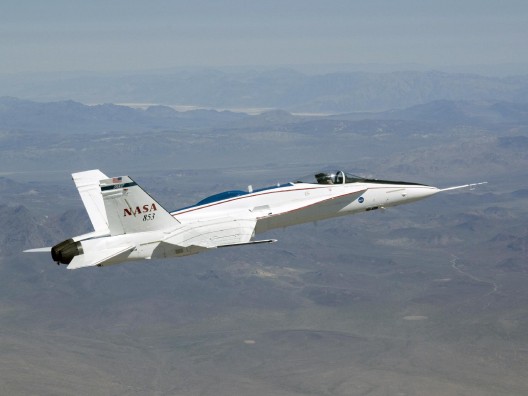Ikhana, a civilian version of the military’s Predator drone, has been used for years at the NASA Dryden Flight Test Center for a multiplicity of roles. Beginning in 2006, Ikhana carried onboard sensor systems that spotted and tracked wildfires for ground and air-based firefighters.
Ikhana was also used to evaluate advanced sensing technology installed on its wings to improve its efficiency. The sensors incorporated fiber optic sensing technology, and were located side by side with traditional sensors. One NASA researcher noted, “There are 3,000 sensors on Ikhana that are imperceptibly small because they’re located on fibers approximately the diameter of a human hair.”
Weight savings on an aircraft with an array of fiber optics would reduce operating costs and improve fuel efficiency, according to NASA. But these new sensors also “enable adaptive wing shape control.”
NASA’s Lance Richards, of Dryden’s Advanced Structures and Measurements Group, says, “’Active wing-shape control represents the gleam in the eye of every aerodynamicist. If the shape of the wing can be changed in flight, then the efficiency and performance of the aircraft can be improved, from takeoff and landing to cruising and maneuvering.”
According to Richards, “Six hair-like fibers located on the top surface of Ikhana’s wings provide more than 2,000 strain measurements in real time. With a combined weight of less than two pounds, the fibers are so small that they have no significant effects on aerodynamics. The sensors eventually could be embedded within composite wings in future aircraft. To validate the new sensors’ accuracy, the research team is comparing results obtained with the fiber optic wing shape sensors against those of 16 traditional strain gauges co-located on the wing alongside the new sensors.”
Richards noted that the sensors could improve aircraft safety by monitoring stress levels at thousands of locations on the airframe throughout its lifetime and reporting on structural “health.” Accumulated data could enhance designer’s ability to craft lighter, stronger structures, reducing fuel costs and increasing range. Such monitoring could also help “prevent situations that might otherwise result in a loss of flight control.”
Lessons from Ikhana, the Choctaw Native American word for “intelligent, conscious, or aware,” have helped make the F/A-18 Full Scale Advanced Systems Testbed (FAST) aircraft more aware – and intensely conscious of its aerodynamic situation at any moment.
Tests with F/A-18 No. 853, modified as part of the Intelligent Control for Performance (ICP) research project, evaluate whether small modifications to existing control laws and mechanisms in the aircraft’s flight control computer can reduce fuel consumption.
ICP involves “a special computer code called a peak-seeking algorithm… programmed into the aircraft’s Airborne Research Test System computer,” and enables precise adjustments to control surface deflections to reduce aerodynamic drag and lead to reduced fuel burn and emissions. This would fulfill at least one goal of NASA’s Environmentally Responsible Aviation (ERA) project.
Tests show a three- to five-percent fuel savings compared to the baseline trim state in two flight conditions, something airlines would relish for their fleets.
Next summer, NASA will apply a new “thin film” sensor from TAO Systems on the aircraft’s upper control surfaces in a move to characterize airflow over the wing. NASA thinks, “This sensor capability could lead to considerable weight reduction, fuel savings, and flight safety enhancement in future aircraft designs by revealing the actual flight loads on an aircraft to help ensure that design loads are not exceeded.”
NASA also projects that this technology “could… reduce the effects of gusts and turbulence on an aircraft when coupled with appropriate flight control algorithms.”
These tests could lead to more aerodynamically efficient, smoother riding aircraft in our future and help make the skies in which they fly cleaner and safer. Technologies that NASA tests now will eventually be incorporated into the jet liners and private aircraft of tomorrow.


